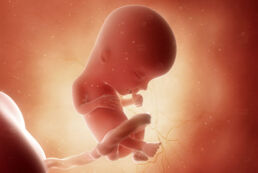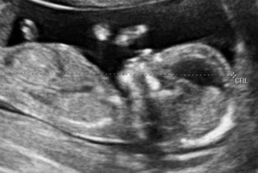Baby's Height and Weight
At the end of the first trimester, i.e. the first 3 months of pregnancy, the baby is about 7-8 centimetres long, the size of a lemon or tangerine. Her/his weight is about 22-25 grams.
Development of the Baby

This first 3 months of the pregnancy journey is the period when you learn that you are expecting a baby and all the organ, bone and muscle structures of the baby are formed.
The baby, which started his/her life as a collection of cells, is called an embryo in about two-thirds of this period. The Greek word for embryo is “newborn”. Between 8 and 10 weeks the baby develops into a foetus (fetus) and by the 10th week it is a full foetus. The fetus means “young individual”. From the 10th week until birth, the baby is called a fetus. In this long development process of the fetus, the formation of organs is completed, muscle and bone structures are strengthened, height and weight increase occurs.
Formation of the Baby
“The formation of the baby occurs during the ovulation period of the woman. Under normal conditions, the average ovulation period in a woman is 6 days.
The probability of fertilization of the egg occurs on average on days 14-3 to 14 +3 starting from the last menstrual period. In this process, the eggs have fully matured to fertilize. Fertilization occurs with the insertion of sperm, which is a male reproductive cell, into the egg, which is the reproductive cell of the woman who has sexual intercourse during the ovulation process or very close to this process.”
Twin and triplet pregnancies occur in the form of identical and separate egg twins/triplets. As a result of fertilization of an egg with a sperm, identical twins/triplets are formed by dividing into two or three zygotes. Separate/fraternal twins/triplets are formed by releasing more than one egg and fertilizing it separately.
“As a result of fertilization of the egg and sperm, a cell called zygote is formed. This new cell continues to divide, becoming a cluster of cells called blastomeres. And in about 3 days, it moves towards the uterus and settles on the inner wall of the uterus. This cell, which is in three layers to complete the whole body of the baby, starts to become an embryo between 4-5 weeks. When the embryo is formed, the foundation of your baby’s organs has already been formed.
The baby has the appearance of a tube extending from the brain to the tail.”
The embryo develops in a fluid-filled bubble called the amniotic sac and grows in this sac throughout the pregnancy. For several weeks, the baby is only fed by a structure called the yolk sac, which is covered with membranes. From the beginning of this month until it is fully formed, the placenta continues to produce blood cells. While the yolk sac continues to provide blood cells to the baby, the placenta and umbilical cord, on the other hand, will begin to perform their duty to hold on to the baby’s mother, and thus to life. The yolk sac (egg sac) disappears completely at the end of the 3rd month. The function of this sac will now be taken over by the bone marrow, spleen and liver.
“His heart gets stronger every day.
At the end of this period, it makes 160-180 beats per minute.”
During the first trimester of pregnancy, your baby’s limbs, such as arms, legs and fingers, form and continue to develop. Tiny fingers with developed touch points at the ends are formed and elongated. In the 2nd month, the fingers, which are adhered to each other with the web structure, begin to decompose at the end of the first trimester.
At the end of this period, the baby’s shoulder and elbow structures continue to form. Cartilage structures have started to ossify gradually. Bone development supports the development of joints. The baby’s skull is more ideally shaped. His neck began to become more and more visible. Its back is even flatter.
Facial features have become more pronounced. The forehead area is wide. As his/her ears grow, they begin to take their normal shape. The inner ear and middle ear are completely formed. At the end of the 1st trimester, his/her eyes moved closer to the front of the face. Her/his eyes are colored.
At the end of the first 3 months, the baby’s digestive system works very well. The baby swallows the amniotic fluid and filters it through the kidneys and intestines, releasing it back into the amniotic fluid as urine. Thanks to the blood pumping system transferred from the mother to the baby’s body, both oxygen and nutrients are delivered to the baby and at the same time the baby’s waste is disposed of from the body.
Ultrasound Image

At the end of the first trimester, your baby will appear in tiny human forms as the skin layer and bones become thicker with each passing week.
In the middle of this period, your baby’s head was the same size as her/his body. By the end of this period, your baby’s head will have grown and you can see that the head is now one-third the size of the body.
You can see your baby kicking and moving his/her arms and fingers.
If his/her hand touches his/her face, the baby can make reflex movements. At the end of the 1st trimester, it is possible to see your baby sticking his/her thumb in his/her mouth and even smiling on the ultrasound.
Some doctors can tell the gender of the baby at the end of this period. Sometimes the baby does not allow this prediction in terms of position.
Changes in the Mother's Body
At the end of the first 3 months of pregnancy, your uterus grows to the size of a large grapefruit.
Signs of pregnancy in the first trimester are as follows:
– Feeling tired,
– Excessive desire to sleep,
– Frequent urge to urinate,
– Interruption of night sleep,
– Nausea, heartburn and indigestion,
– Swelling, pain and tenderness in the breast area,
– Thickening in the waist area,
– Headaches
– Constipation
– Dryness, itching and acne on skin.
– Groin pains.
– Bleeding gums
– Dark spots on the skin,
– Sexual desire or aversion.
Binary Test
The first trimester screening test is the Dual Test (test performed between 11-14 weeks), which is one of the routine tests of pregnancy. With this test, the nuchal translucency is analysed on ultrasound and the baby is evaluated for Down syndrome.
Points need to be considered
You may have bleeding gums. Brushing your teeth regularly relaxes you.
At the end of the first trimester, you can buy comfortable bras as your breasts will grow enough. If you prefer non-wired breastfeeding bras, you can continue to use these bras after birth.
Nausea and Vomiting
– Do not consume fatty foods,
– Eat often and little,
– Snack on a low-salt cracker before getting out of bed,
– Drink mint tea.
If you have frequent severe vomiting, you need to take serum in the hospital so that the lost water and minerals can be replaced. If your nausea and vomiting continue to be severe, your doctor will recommend an anti-nausea medication.
Nutrition
Eat plenty of protein and calcium-containing foods in a balanced way every day. Drink plenty of water. Eat foods that contain magnesium, such as bananas, to prevent cramps.
At the end of this period, you should start iron supplementation as the need for iron will arise. Do not forget to eat plenty of vegetables and salads in case the iron medicine causes constipation.
Try not to overeat. An extra 300 calories a day is enough. In twin pregnancies, this rate should be 500-600 calories per day.
Constipation Problem
The most important reason for this is that it causes the growing uterus to work slowly by pressing on the intestines. To prevent constipation
Eat plenty of fibrous food. Since fibrous foods can cause gas and bloating, consume these foods by spreading them over different meals in a day.
– Eat dried legumes.
– Consume dried fruit varieties at snacks.
– Try to drink plenty of fluids.
– Compote and consume dried fruits.
If you have not been able to resolve your constipation problem despite all this, consult your doctor.
Canbebe on Social Media!
Join our community of mothers and fathers on social media. Be close to caring community, sharing advices between each other on our everyday life with our baby.
